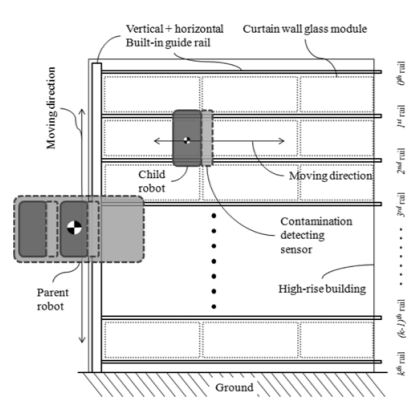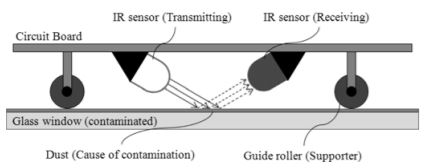Sensor Based Motion Planning and Estimation of Highrise Building Façade Maintenance
Modern day buildings are becoming more and more advanced towards high-rise and mega scale buildings, but they have severe limitations regarding their high construction and maintenance costs. Existing methods for cleaning, painting and inspection are highly dependent on man power, they also have high socio-economic losses due to accidents. The demand for automated maintenance work for high-rise buildings performed in a dangerous environment is increasing.
To address the above problems, this paper suggests the built-in guide-type multi-robot concept as a strategy to distribute risks and improve the efficiency of the maintenance system for high-rise buildings. Furthermore, a motion planning algorithm for façade glass cleaning among the various maintenance tasks is proposed. Around 20 built-in guide-type robots must move along predefined rails, but they can measure the contamination level of the building’s façade using contamination detecting sensors and can change their movement speeds accordingly. Thus, they move slowly at places with a high contamination level for focused cleaning, and move fast at places with a low contamination level. Faster cleaning is ensured by effectively distributing these cleaning robots to different floors. The performance of the proposed method has been proven through simulations of cleaning robots working in a high-rise building.
The multi-robot system can be largely divided into the ‘parent-robots’ and the ‘child-robots’. One parent-robot can transport n-number of child-robots to the movement site. Each robot can move only vertically or horizontally. The façade maintenance task of an actual high-rise building is performed by the n child-robots that have a modular façade maintenance tool.
A light source was installed outside the façade glasses, and the quantity of light passing through the contaminated glasses was measured and divided into three levels of contamination. and the contamination levels were defined as 1, 2, and 3 (Fig. 5). The luminance of light passing through the contaminated glasses was 19 lux for contamination level 3 (very contaminated state), 27 lux for contamination level 2 (moderately contaminated state), and 35 lux for contamination level 1 (relatively clean state).
Based on the contamination states of the glass a motion planning of the Child-robots is determined and a maximum clean velocity and a clean time can be approximated via simulation, of which results are further stated in the article itself.

